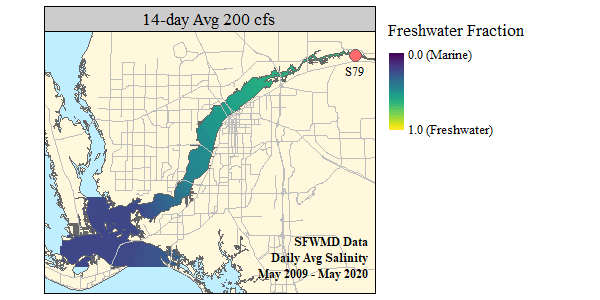South Florida Estuaries
Keywords: Okeechobee, water level, LOSOM
Estuaries are the transition zone from fresh to saltwater and to function properly requires a balance of freshwater inputs. These inputs create a gradient of fresh to saline waters that are important for the composition, distribution of vegetative communities and wildlife. However too much freshwater in the estuary can be detrimental to the health of the ecosystem.
Here we have two estuaries and upstream watersheds, the Caloosahatchee and St Lucie river estuary and watershed. Both are connected to Lake Okeechobee thank to the landscape modifications in the early 1900s.

Caloosahatchee and St Lucie watersheds.
The Caloosahatchee estuary receives freshwater either from the upstream watershed in the form of runoff or discharges from Lake Okeechobee. Similarly, the St Lucie Estuary (on the east coast) receives either basin runoff from a comparatively smaller watershed or discharges from the Lake. The St Lucie river has the added benefit of being able to return water to Lake Okeechobee (AKA backflow) rather than discharging to the Estuary. While this backflow may prevent extreme or damaging discharges to the St Lucie Estuary, it is detrimental to lake ecology by adding nutrients to an already nutrient-rich system. In extreme cases some water can be returned to the lake via S77, but this is rare.

May 1978 - Apirl 2021 peroid of record annual mean discharge volume from source within the Caloosahatchee and St Lucie watersheds to each estuary. Values above bars are average discharge volume in Ac-Ft WY-1.
Estuaries rely on a balance fresh and saline water. Here in the Caloosahatchee River Estuary the main source of freshwater is the S-79 structure. As discharges from this structure increases the estuary becomes more fresh with discharges about 2600 cfs (~5157 Ac-Ft d-1) causing significant damage to marine species.
